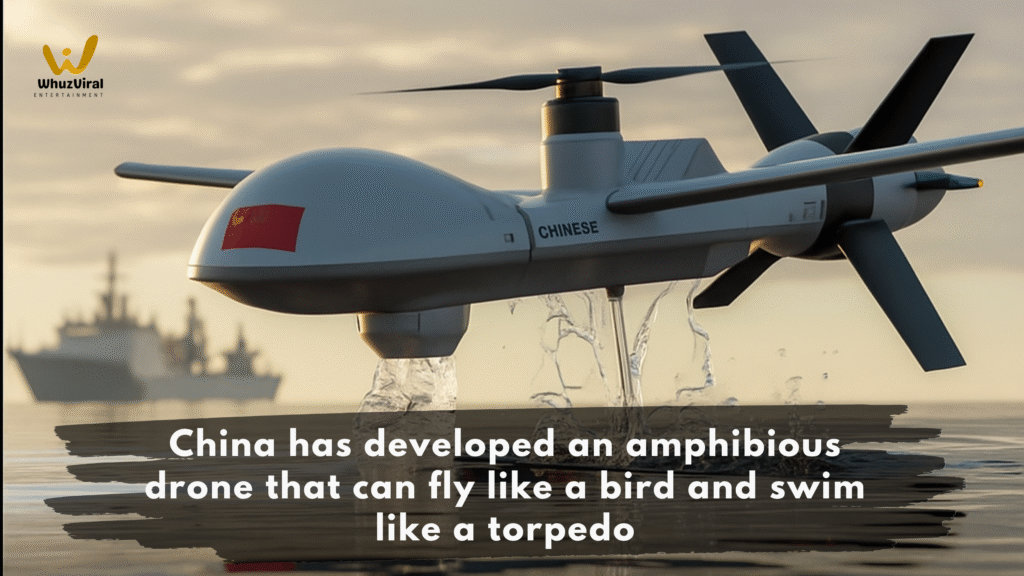
In a coastal testing facility near Shandong, China, a team of engineers has achieved what once sounded like science fiction: a China drone that flies and swims, seamlessly shifting from air to sea in seconds. Nicknamed SeaDuck, this dual-environment drone could reshape the future of surveillance, research, and even disaster response.
Forget needing separate drones for air and underwater missions—this machine does both in a single flight. And it doesn’t just switch modes; it transforms mid-air, dives into the ocean, and operates like a fully functional submarine.
1. What Exactly Is the SeaDuck Drone?
The China drone that flies and swims is a new kind of amphibious drone designed to handle missions across two vastly different environments.
It begins as a quadcopter, soaring through the sky like a bird. Once it reaches its target, it folds its rotors, activates an underwater propulsion system, seals its body against water pressure, and dives straight down—becoming a torpedo-shaped submersible.
This transformation takes less than 10 seconds, which means SeaDuck can seamlessly switch from aerial reconnaissance to underwater scanning without any downtime.
2. The Engineering Marvel Behind Its Design
SeaDuck’s construction blends aerospace and marine engineering:
- Titanium Alloy Body: Lightweight yet strong enough to handle both high-speed winds and deep-sea pressure.
- Seamless Seals: Protect its electronics from saltwater and maintain structural integrity under high pressure.
- Dual Propulsion: Quad-rotor system for flight; fins and rear thrusters for underwater movement.
- Sensor Arrays: Equipped with thermal cameras, sonar scanners, and high-resolution imaging tools for land, sea, and air surveillance.
This meticulous design is why the China drone that flies and swims can function in conditions that would normally require two separate vehicles.
3. How SeaDuck Switches Modes
The transformation process is where SeaDuck truly shines:
- Flight Mode: Launches and navigates like a standard aerial drone.
- Pre-Dive Transition: Rotors fold inward, and the drone’s hull seals itself.
- Dive Mode: Using gravity and propulsion, it enters the water without creating turbulence.
- Underwater Propulsion: Fins and thrusters activate, allowing it to swim like a torpedo.
- Re-Emergence: When the mission is complete, it surfaces, switches back to rotor flight, and returns to base.
This smooth transition means no recovery vessel or manual operation is required—a huge leap for autonomous robotics.
4. Military Uses for SeaDuck
The China drone that flies and swims is already making waves in military circles.
- Island Surveillance: Conducting reconnaissance over contested islands and maritime zones.
- Underwater Cable Monitoring: Protecting critical undersea communication lines.
- Port Defense: Scanning for underwater threats like mines or unauthorized vessels.
- Swarm Deployment: Field tests are underway to deploy hundreds of SeaDucks simultaneously, creating a coordinated, multi-layered surveillance network.
This isn’t just an innovation—it’s a strategic advantage that could alter naval defense worldwide.
5. Civilian and Scientific Applications
SeaDuck isn’t limited to defense. Civilian and scientific applications may be even more transformative:
- Marine Biology: Tracking migration patterns and studying endangered species.
- Environmental Research: Monitoring coral reef bleaching or ocean acidification.
- Disaster Relief: Searching submerged urban areas during floods or tsunamis.
- Underwater Infrastructure: Inspecting oil pipelines, ship hulls, and offshore rigs.
The drone’s ability to do all this autonomously could save millions in research costs while enabling safer and faster missions.
6. Real-World Scenario: SeaDuck in Action
Here’s how a mission might unfold:
A SeaDuck drone launches from a coastal command center to survey a suspected breach in an undersea cable. Upon reaching the location, it dives underwater, scans the damage with sonar, and sends real-time data back to operators.
Mission complete, it resurfaces, switches back to flight mode, and returns to base—no ships, no divers, no delays.
This efficiency is exactly why experts believe this China drone that flies and swims will be adopted worldwide.
7. The Future of Amphibious Drones
As impressive as SeaDuck already is, its future iterations may be even more groundbreaking:
- Increased Underwater Endurance: Extending navigation time from 4 hours to 10.
- AI-Enhanced Navigation: Smarter autonomous pathfinding for complex missions.
- Payload Upgrades: Ability to carry scientific equipment or repair tools.
- Stealth Technology: Enabling military-grade covert operations.
If realized, these advancements will redefine what dual-environment drones are capable of.
Video: China’s Feiyi amphibious drone in action—watch it seamlessly transition between air and water.
Why SeaDuck Is a Game-Changer
The China drone that flies and swims isn’t just a machine—it’s a technological shift. With it, a single drone can replace aircraft, submarines, and even rescue vehicles in certain scenarios.
For China, it’s a leap forward in innovation and naval capability. For the world, it’s proof that the boundaries between air and sea are disappearing.
Key Takeaway
With its ability to fly like a bird and swim like a torpedo, the SeaDuck drone represents a paradigm shift in robotics and surveillance technology.
Whether it’s used for research, defense, or humanitarian efforts, the China drone that flies and swims is proof that the future of amphibious technology has arrived—and it’s more incredible than anyone expected.

Frequently Asked Questions (FAQ)
1. What is the China drone that flies and swims?
Meet the China drone that flies and swims, nicknamed SeaDuck. Imagine a quadcopter that doesn’t just soar through the sky but also dives underwater like a mechanical penguin. This amphibious marvel doesn’t need extra hardware—it simply transforms mid-air into a fully functional underwater vehicle. Think of it as one drone, two worlds, endless possibilities.
2. How fast does the SeaDuck drone transform between air and water?
Faster than you can say “mission accomplished.”
The SeaDuck takes only 5–10 seconds to shift from air mode to submersible mode. It folds its rotors, locks its titanium hull tight, and activates underwater thrusters. One moment it’s a bird; the next, it’s a fish. No extra equipment, no recovery vessel—just pure, seamless transformation.
3. What makes the SeaDuck drone unique?
What doesn’t? For starters, it’s built with lightweight titanium alloy, giving it the strength to withstand ocean depths and fierce winds. It carries dual-sensor arrays for sonar and infrared imaging, meaning it can scan ship hulls, inspect harbors, or map coral reefs—all on the same trip. This is not just a drone; it’s a hybrid reconnaissance machine with wings and fins.

4. Is the technology proven or experimental?
This isn’t science fiction—it’s already happening.
According to reputable outlets like DefenseMirror and Interesting Engineering, the SeaDuck has been successfully tested at coastal facilities near Shandong, China. Engineers are even preparing it for swarm deployment—picture hundreds of these drones patrolling above and below the surface.
5. What are the possible applications for the SeaDuck drone?
The SeaDuck isn’t just a military toy—it’s a multi-purpose game-changer. Here’s where it shines:
- Military reconnaissance: Inspect islands or underwater cables without sending ships.
- Scientific research: Map coral reefs, study marine ecosystems, and track ocean temperatures.
- Disaster relief: Deploy during floods or search-and-rescue missions without risking human lives.
- Port and harbor inspections: Scan ship hulls for damage or hidden threats.
- Wildlife tracking: Observe aquatic animals up close—without disturbing them.
In short, if it involves air, water, or the space in between, SeaDuck is ready.
The ICC’s Charges Against Rodrigo Duterte
Introduction: When Domestic Power Meets International Justice On a humid September morning in 2025, news…
A Father’s Burden: Turning in His Own Son, Tyler Robinson, in Charlie Kirk Case
Nine days ago, lives changed forever on the campus of Utah Valley University. A public…
Groundbreaking “Third Nostril Surgery” Saves 19-Year-Old from Deadly Spinal Tumor
When medical experts call something “inoperable,” most patients feel their hope collapsing. Yet, medical history…
🚨 Ghost Flood Control Project in Bulacan: Marcos Orders Blacklist and Legal Action Against Contractor
Video: President Ferdinand “Bongbong” Marcos Jr. inspects the alleged ₱55-million “ghost” reinforced concrete river wall…
China Drone That Flies and Swims: 7 Stunning Facts About the Shape-Shifting SeaDuck
In a coastal testing facility near Shandong, China, a team of engineers has achieved what…
Nearly 4,000 Undocumented Filipinos Face Deportation from the US: A Wake-Up Call for OFWs
🧭 Introduction: Why This Matters to Every OFW As an OFW currently teaching English in…




